|
The
phosphorus (P) availability to plants may
be limited by its low abundance in the soil, but also, and very commonly, by its
adsorption onto various soil minerals.
In acidic soils, phosphorus may be
adsorbed by iron or aluminium oxides, and various clay minerals. Many of the
most fertile and productive soils in tropical zones are derived from volcanic
material containing allophane minerals, which have a large phosphorus fixing
capacity. Phosphorus deficiency is often the major limitation to crop growth on
these soils, particularly where previous cropping has caused a depletion of soil
organic matter and increased acidification. Phosphorus deficiency is also common
on highly weathered tropical soils and siliceous
sands; in fact, few soils are naturally well endowed with this nutrient.
In calcareous
soils, phosphorus may be adsorbed by calcium carbonate, or precipitated as
calcium phosphate. The ability of sweetpotato to take up phosphorus may also be
reduced by high pH.
Sweetpotato is reputed to be relatively
tolerant of low soil phosphorus status. A number of fertiliser trials in the USA
have shown little or no yield responses of sweetpotato to the application of
phosphorus fertilisers. In these trials, it appears that residual phosphorus
from previous crops was sufficient to supply the needs of the sweetpotato crop.
Sweetpotato’s efficiency in obtaining
soil phosphorus is due in part to its association with vesicular-arbuscular mycorrhizae
(VAM). These ubiquitous soil fungi invade the
plant roots and feed on its sugars, and in return they assist with the capture
of phosphorus from soils with low phosphorus availability. Mycorrhizal infection
has been shown to increase sweetpotato growth and yield in a number of studies.
The extent of mycorrhizal infection has been positively correlated with yield,
and negatively correlated with the crop response to phosphorus fertiliser, over
a range of soils in the Highlands of Papua New Guinea. The effect is greatest
under low phosphorus fertility, and V
AM may have no benefit or even a negative
effect on crops which are well supplied with phosphorus.
Although sweetpotato may yield relatively
well under low phosphorus conditions, phosphorus deficiency
is still a very common cause of reduced yields. Many cases have been reported
where phosphorus fertilisers have dramatically increased yield. It is clear from
these examples that wider use of phosphorus fertilisers will play an important
role in improving sweetpotato production, as it has for other crops. However, it
is also evident that rates of phosphorus fertilisers recommended for other crops
may be excessive and wasteful when used on sweetpotato.
Mild to moderate phosphorus deficiency
may be difficult to recognise in the field. Growth may be reduced to less than
one half that of well nourished plants, without the appearance of any
identifiable symptoms of phosphorus deficiency. Mild phosphorus
deficiency is often associated with a darker than normal, bluish green colour of
the foliage. Unlike nitrogen deficiency, young to mature leaves remain dark
green at all levels of severity. In a young crop, only severely stuntedplants will show obvious symptoms on the older leaves. However, on
less severely deficient crops symptoms may develop as the crop matures.
The first sign of phosphorus deficiency
is usually the premature senescence of
older leaves. In most (but not all) cultivars, yellowing is preceded by the
appearance of purple anthocyanin pigments, producing a range of autumnal colours
in the senescing leaves. Yellowing may spread from discrete interveinal
patches, which typically become cleared of anthocyanin
pigment, or may be more general, but often affecting one half of the blade
more than the other. In this case, the chlorotic areas may appear orange or red
due to the overlying anthocyanin pigments. Necrotic
lesions may
develop in the chlorotic zones, and the
necroses spread as irregular patches until the leaf blade is entirely brown and
dry. In some cultivars (eg. Markham) no yellow or purple phase precedes the
necrotic lesions, which appear on green tissue. However, as in other cultivars,
those parts of the leaf blade which are not yet necrotic turn yellow in the
final stages of senescence.
Some cultivars may develop purple pigmentation on the upper surface of the youngest leaves, particularly on the
veins. This may resemble nitrogen deficiency, although in phosphorus
deficiency it is less common among cultivars, and is less strongly veinal.
Potassium
and magnesium deficiencies also cause
chlorosis on older leaves, but in phosphorus deficiency chlorosis usually does
not retain a distinct interveinal pattern, as is typical of potassium or
magnesium deficiencies. The appearance of red pigmentation on the veins of young
leaves may resemble nitrogen deficiency. However, in the case of phosphorus
deficiency, there is no general chlorosis of the plant.
Sweetpotato feathery mottle virus (SPFMV)
may also induce chlorotic spots surrounded by purple tissue on older leaves.
Lesions caused by the virus are randomly scattered over the leaf blade, and are
not restricted to the oldest leaves on the vine. The symptoms do not progress to
cause necrotic lesions or orange and red colours on the senescing leaves, as
seen in P deficiency.
In solution culture experiments, a
critical concentration of 0.22% P has been estimated in the blades of the 7th
to 9th youngest leaves. Concentrations between 0.26 and 0.45% P were
associated with maximal growth.
Little work has yet been done to
calibrate soil tests for predicting yield response of sweetpotato to applied
phosphorus. Available phosphorus levels in the range 5 - 7 mg/kg (Olsen’s
method) have been suggested as the threshold for deficiency in crops with a low
phosphorus requirement, such as sweetpotato. This is supported by a report of
positive regressions between available phosphorus and sweetpotato yield, on
soils ranging from 0.6 to 5 mg/kg available phosphorus (Olsen’s method),
indicating that phosphorus is yield-limiting within this range. Soil solution
phosphorus concentrations may also be measured. It has been suggested that 0.01
mg/kg is the minimum soil solution concentration of phosphorus needed to
maximize yield of sweetpotato, and a soil solution concentration of 0.003 mg/kg
corresponded to a yield 70% of the optimum. It should be noted that these
measurements include only part of the phosphorus in soil organic matter, which
may represent a considerable proportion of the phosphorus available to the crop
in some soils.
Measurements of phosphate binding
capacity, in addition to plant-available phosphorus, have been used to estimate
the quantity of phosphorus fertiliser required on phosphate-fixing soils.
Phosphate binding can be estimated using phosphate sorption isotherms (Fox and
Kamprath, 1970), or phosphate retention (Saunders, 1974). These methods have
been described by Rayment and Higginson (1992).
Cultural control
Phosphorus deficiency can be corrected by
broadcast, band or spot application of soluble phosphorus sources, such as
single or triple superphosphate, ammonium phosphate, or mixed fertilisers
(containing N, P and K, with or without other nutrients). Band or spot
application of phosphorus fertilisers is recommended on strongly P fixing soils.
Rock phosphate is a relatively cheap
alternative to more soluble fertilisers. Rock phosphate should be well
incorporated into the soil, and is usually only effective on acidic soils, due
to its very low solubility at neutral to high pH. Being slow to dissolve, rock
phosphate may have a greater residual effect on subsequent crops.
Single superphosphate (10% P) also
contains sulfur and calcium, and is recommended in soils where these nutrients
are also low. Triple superphosphate (TSP, 24% P) also contains calcium, but not
sulfur.
A sweetpotato crop will remove about 8-40
kg P/ha from the soil depending on yield, but on phosphorus-fixing soils, much
higher rates of application (>100 kg P/ha) may be needed in the first year of
application. In subsequent years, lower rates may suffice to maintain an
adequate supply of phosphorus to the crop.
Traditional subsistence methods of
cultivating sweetpotato, including the incorporation of substantial amounts of
organic matter and using large, healthy runners for planting, add significant
amounts of phosphorus, as well as other nutrients. Decomposition of organic
matter provides a steady supply of plant-available phosphorus even on highly
P-fixing soils. An important part of the response of sweetpotato crops to
organic matter additions is due to improved phosphorus nutrition.
Bingham,
F.T. 1962. Chemical tests for available phosphorus. Soil Science 94, 87-95.
Bouwkamp, J.C. 1985. Production requirements. In: Bouwkamp, J.C.
(ed), Sweet Potato Products: A Natural Resource for the Tropics. CRC Press, Boca
Raton, Florida. pp 9-33.
de de Geus, J.G. 1967. Fertilizer Guide for Tropical and
Subtropical Farming. Centre d'Etude de l'Azote, Zurich.
Dowling, A.J., Konabe, B. and Tigat, R. 1994. Nutritional
assessment of steeply sloping soils from Aiyura in the Eastern Highlands of
Papua New Guinea. Papua New Guinea Journal of Agriculture, Forestry and
Fisheries, 37(2), 23-29.
Floyd, C.N., Lefroy, R.D.B. and D’Souza, E.J. 1988. Soil
fertility and sweet potato production on volcanic ash soils in the highlands of
Papua New Guinea. Field Crops Research 19, 1-25.
Fox, R.L. and Kamprath, E.J. 1970. Phosphate sorption isotherms
in evaluating the phosphate requirements of soil. Soil Science Society of
America Proceedings 34, 902-907.
Fox, R.L., Hashimoto, R.K., Thompson, J.R. and de la Peña, R.S.
1974. Comparative external phosphorus requirements of plants growing in the
tropics. Tenth International Congress on Soil Science (Moscow) 4, 232-239.
Goodbody, S. and Humphreys, G.S. 1986. Soil chemical status and
the prediction of sweet potato yields. Tropical Agriculture (Trinidad) 63,
209-211.
Halavatau, S., Asher, C.J. and Bell, L.C. 1996. Soil fertility
and sweet potato research in Tonga - Nitrogen and Phosphorus. In: Craswell, E.T.
Asher, C.J. and O’Sullivan, J.N. (eds.) ACIAR Proceedings No.65: Mineral
nutrient disorders of root crops in the Pacific. pp 58-64.
Ila’ava,
V.P. 1997. Effects of soil acidity factors on the growth of sweet potato
cultivars. Ph.D. thesis, The University of Queensland, Australia.
Jones,
A. and Bouwkamp, J.C. 1992. Fifty years of cooperative sweetpotato research
1939-1989. Southern Cooperative Series, Bulletin No. 369, Louisiana Agricultural
Experiment Station, Baton Rouge, USA.
Kabeerathumma, S., Mohankumar, B. and Potty, V.P. 1986. Efficacy
of rock phosphate as a source of phosphorus to sweet potato. Journal of the
Indian Society for Soil Science 34, 806-809.
Kandasamy, D., Palanisamy, D. and Oblisami, G. 1988. Screening
of germplasm of sweet potato for VA-mycorrhizal fungal occurrence and response
of the crop to the inoculation of VAM fungi and Azospirillum. Journal of Root
Crops 14, 37-42.
Khasa, P., Furlan, V. and Fortin, J.A. 1992. Response of some
tropical plant species to endomycorrhizal fungi under field conditions. Tropical
Agriculture 69, 279-283.
Leonard, O.A., Anderson, W.S. and Gieger, M. 1949. Field studies
on the mineral nutrition of the sweetpotato. Proceedings of the American Society
for Horticultural Science 53, 387-392.
Mulongoy, K., Callens, A. and Okogun, J.A. 1988. Differences in
mycorrhizal infection and P uptake of sweet potato cultivars (Ipomoea batatas
L.) during their early growth in three soils. Biology and Fertility of Soils 7,
7-10.
Negeve, J.M. and Roncadori, R.W. 1985. The interaction of
vesicular-arbuscular mycorrhizae and soil phosphorus fertility on growth of
sweet potato (Ipomoea batatas). Field Crops Research 12, 181-185.
Nishimoto, R.K., Fox, R.L. and Parvin, P.E. 1977. Response of
vegetable crops to phosphorus concentration in soil solution. Journal of the
American Society for Horticultural Science 102, 705.
O’Sullivan, J.N., Asher, C.J. and Blamey, F.P.C. 1997. Nutrient Disorders
of Sweet Potato. ACIAR Monograph No. 48, Australian Centre for International
Agricultural Research, Canberra, 136 p.
Paterson, D.R., Taber, RA., Earhard, D.R. and Cushman, K.E. 1987. Response of
"Jewel", "Topaz", and "Cordner" Ipomoea batatas
cultivars to endomycorrhizal fungi in greenhouse and field experiments.
HortScience 22, 1107.
Paula, M.A., Urquiaga, S., Siqueira, J.O. and Dobereiner, J.
1992. Synergistic effects of vesicular-arbuscular mycorrhizal fungi and
diazotrophic bacteria on nutrition and growth of sweet potato (Ipomoea batatas).
Biology and Fertility of Soils 14, 61-66.
Rayment, G.E. and Higginson, F.R. 1992. Australian laboratory
handbook of soil and water chemical methods. Inkata Press, Australia.
Saunders, W.M.H. 1974. Effect of superphosphate topdressing on
phosphate and sulphate retention. New Zealand Soil News 22, 15-22.
Tisdale, S.L., Nelson, W.L. and Beaton, J.D. 1993. Soil fertility and
fertilizers, 5th Edition. Macmillan, New York. p 189.
Weir, RG. and Cresswell, G.C. 1993. Plant Nutrient Disorders 3. Vegetable Crops. NSW
Agriculture; Inkata Press, Australia.
Contributed
by:
Jane O'Sullivan |
Characteristics
and occurrence
Symptoms
Confusion
with other symptoms
Diagnostic
tests
Management
References
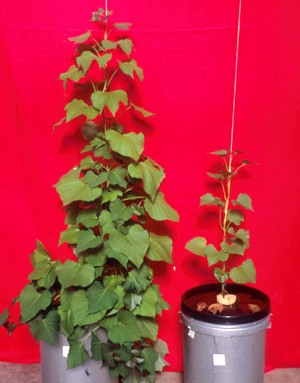
Reduced growth in P-deficient plant (right) without obvious symptoms of
disorder.
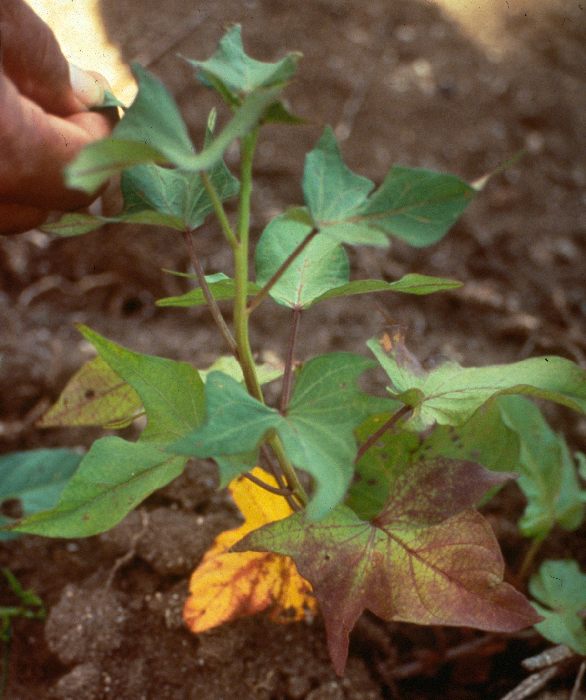
Purpling and yellowing of older leaves in a young, stunted
plant, but new leaves are dark green (J. O'Sullivan).

Autumn leaf colours and increased flowering are
typical signs of P deficiency (C. Asher).
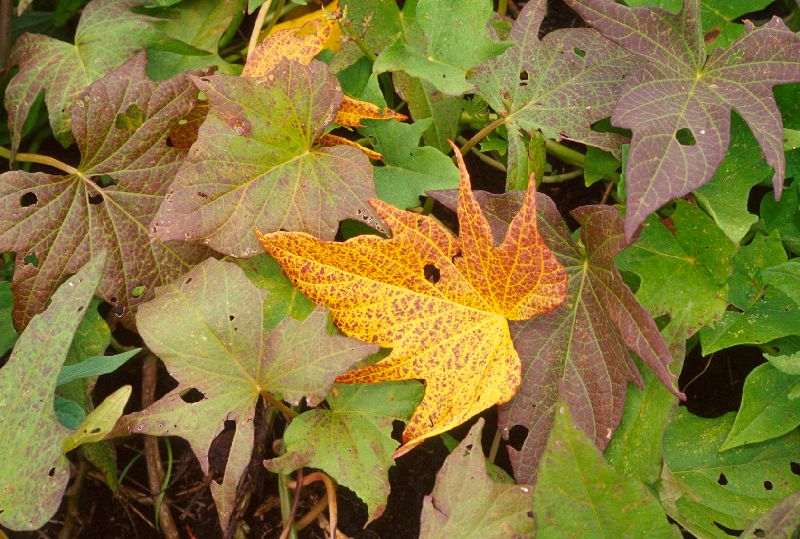
Purpling on older leaves, in this case widely distributed on
interveinal tissue (J. O'Sullivan).
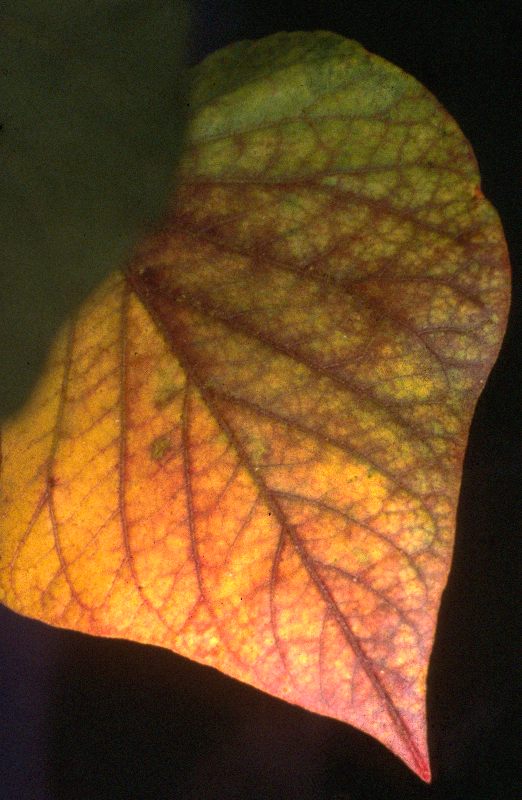
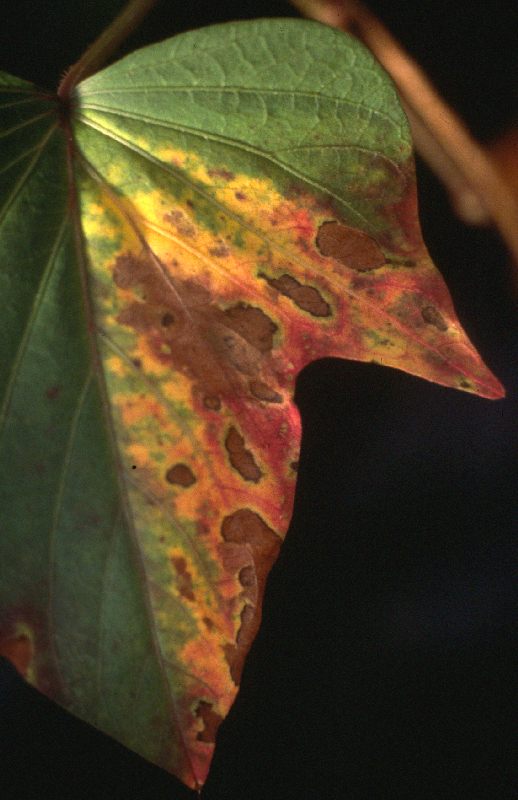
Purpling is often concentrated on veins. Yellowing and necrosis
is often asymmetrical (J. O'Sullivan).
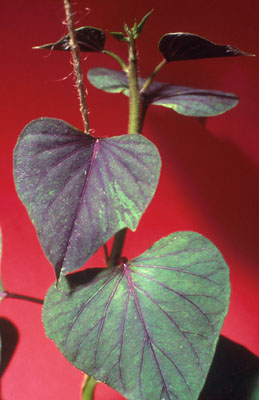
In some varieties, P deficiency induces purpling of tips which are
normally green (J. O'Sullivan). |

